June 2016.
Zika continues to be big news. It has been connected with birth defects
in South America and now one case of microcephaly in mother who became
infected in South America and delivered here in North America. Over
20,000 cases of microcephaly occurs in America every year. It is caused
by many problems during pregnancy:
1.
Certain infections during pregnancy, such as rubella,
toxoplasmosis, or cytomegalovirus
2. Severe malnutrition, meaning a lack of nutrients or not getting
enough food
3. Exposure to harmful substances, such as alcohol, certain drugs, or
toxic chemicals
4. Interruption of the blood supply to the baby’s brain during
development
5. And now Zika.
All these conditions occur in South America and other developing
countries at a higher incidence than here in the States. The Zika virus
is new to South America so many people are being infected. There are
normally no or mild symptoms from the illness. The children who are
getting infected are then immune to it and will not have the illness
when an adult who gets pregnant. So they should want their children to
get the illness to protect them. It works like a vaccine to prevent
birth defects later in life. There are a lot of cases of microcephaly
now from Zika but when the children who are immune grow up, then the
number of cases will be extremely rare. They estimate 1% of pregnant
women will have a damaged newborn with Zika but many cases are not
reported since there are such mild symptoms. The damage rate is
probably far less. America will spend big dollars to develop a vaccine
since the disease may eventually come here. (I mentioned before I worry
more about Dengue Fever.) Many people will want the vaccine and
especially adults in child bearing years should get it. (Interesting
how many people who are against the MMR will want this vaccine yet we
give Rubella vaccine to prevent such problems.) Before the chicken pox
vaccine, we used to have chicken pox parties where the parent would
expose their kids to it. Then get the disease as a child instead of as
an adult when it would be more dangerous.
Some diseases are less dangerous in children than adults and some are
more dangerous as kids like Dengue. You do not hear much about West
Nile like we did years ago. It came to America in 1999 and there are
outbreaks in different states in different years. In Texas the yearly
rate of West Nile was 27-260 cases every year from 2001 to 2011. Then
in 2012 there were 1868 reported cases. There were a lot of susceptible
people in the population and more mosquitos with the virus that year.
The next year there were 183 cases. West Nile is dangerous for the
elderly although severe disease is only 1%. Children hardly ever are
hospitalized with it. But I see 20-30 cases of probable West Nile every
year but they never get diagnosed since it is mild and require expensive
yucky tests for a disease I cannot treat. I tell parents it is not a
bad thing since they are then immune to it and will not get it when
older and more deadly. Also there was a lot on the news about West Nile
so doctors were testing more patients for the infection. There
sometimes is an increase in disease because the doctors and population
are looking harder for the disease and not an actual increase the number
of cases. The West Nile story sounds similar to Zika situation huh?
Protect your children from mosquito bites and especially when traveling
to South America, Central America, Mexico, and other countries with high
numbers of mosquitos. Not to prevent Zika but to prevent Dengue,
malaria, and other worse diseases.
Here
is a not-so-complete list of diseases from Mosquitos.
Banna Fever
Bunyamwera fever
Bwamba Fever
Chikungunya,
Dengue fever,
Eastern Equine Encephalitis
Jamestown Canyon fever
Japanese encephalitis
La Cross encephalitis
Malaria
Mayaro virus disease
Pogosta disease
Rift Valley Fever,
Ross River fever
Saint Louis encephalitis
sleeping sickness
Tropical eosinophilia
Venezuelan equine encephalitis,
West Nile Fever,
Western Equine Encephalitis,
Yellow Fever,
Zika fever
Feb 2016. The news is having a field day
with the Zika virus which is not good if you are pregnant. Otherwise
causes little illness and most have no symptoms. It is connected with
microcephaly in newborns and is tragic when it happens. The disease has
spread rapidly from Africa to South and Central Americas and Mexico and
Caribbean Islands. But so has Dengue Fever and Chikungunya viruses
spread to the same areas since the 1980s. There were some cases just
reported in the Hawaiian Islands. 22,000 deaths occur every year from
Dengue Fever and most of those are children. A vaccine is being
produced against Dengue but only 70% effective to the four strains. In
Thailand and Indonesia Dengue is the leading cause of hospitalization
and death in children. I worry a lot more about Dengue than Zika.
The Zika virus has only one strain reported
to date and like the article at my web site on West Nile Disease, once
immune to it as a child, then you won’t have trouble as an adult.
Eventually most children in those areas of the world will become immune
so the disease when pregnant will be rare if not zero. In the mean time
there will be tragic cases. The hope is that all these diseases will
not come to America. Probably they will not come here in great numbers
because we do not have the rain fall they have and We have better
control of mosquitoes. Pregnant or potential pregnant females should
not visit these countries south of the boarder since most Americans will
not be immune to them. Also pregnant women should not have unprotected
intercourse with men who have recently visited the disease areas. From
the maps you can see it includes Mexico and the Caribbean Islands.
Dengue Virus
Approximately 1 in 4 people infected will
develop disease.
Incubation: 4–7 days (range: 3–14 days)
Some patients may develop life threatening
consequences and require hospitalization.
Since there are 4 distinct dengue viruses, a
person can be infected up to 4 times. Infection with each dengue virus
type confers lifetime immunity for that specific virus type.
http://www.cdc.gov/dengue/
Chikungunya Virus
Approximately 3 in 4 people infected will
develop disease.
Incubation: 3–7 days (range: 2–12 days)
Acute symptoms typically resolve within 7-10
days.
Persons at risk for severe disease include
neonates exposed intrapartum, older adults, and persons with underlying
medical conditions.
Infection is thought to confer lifetime
immunity.
http://www.cdc.gov/chikungunya/geo/index.html
Zika
virus
About 1
in 5 people infected with Zika virus become ill (i.e., develop Zika).
The most
common symptoms of Zika are fever, rash, joint pain, or conjunctivitis
(red eyes). Other common symptoms include muscle pain and headache. The
incubation period (the time from exposure to symptoms) for Zika virus
disease is not known, but is likely to be a few days to a week.
The
illness is usually mild with symptoms lasting for several days to a
week.
Zika
virus usually remains in the blood of an infected person for a few days
but it can be found longer in some people.
Severe
disease requiring hospitalization is uncommon.
Microcephaly in infants if mother infected while pregnant.
Deaths
are rare.
http://www.cdc.gov/zika/index.html
http://www.medicalnewstoday.com/articles/179471.php

Zika progression in the world
2007
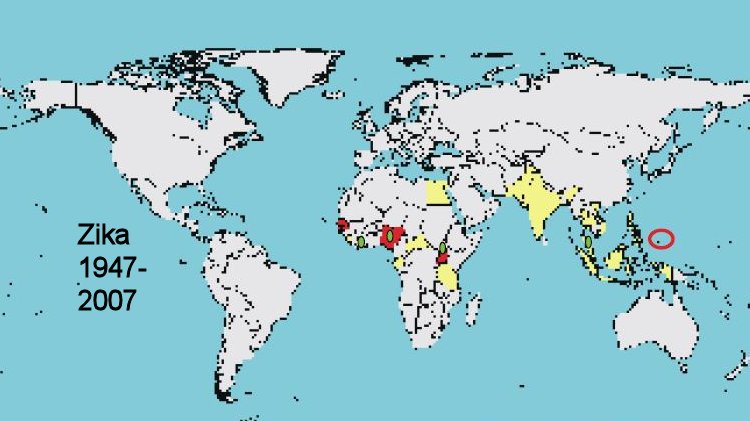
2015
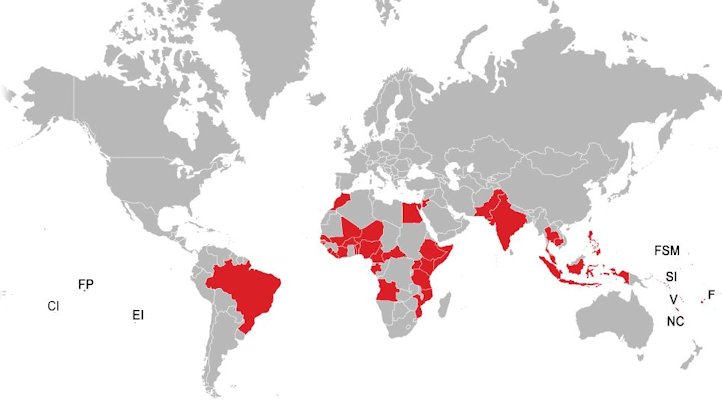
2016
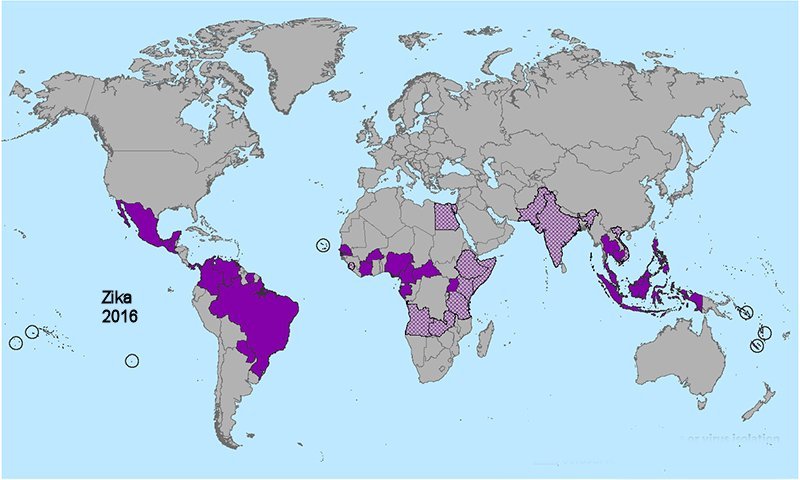
Dengue Fever world progression:
Very similar to Zika.
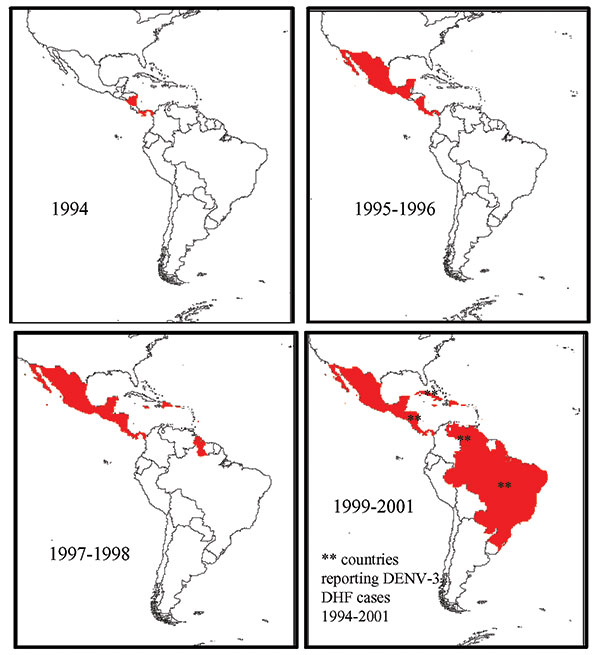
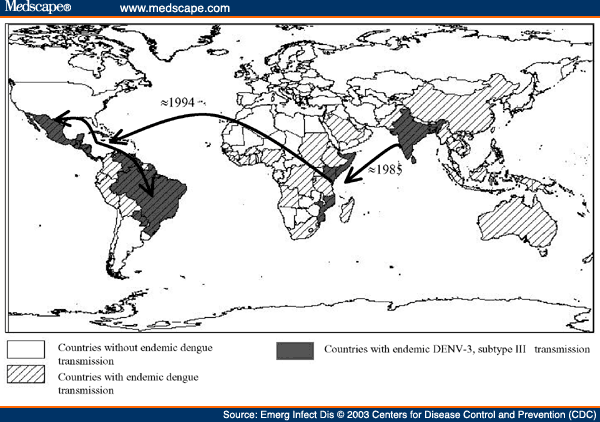
NOW FOR A DIFFERENT OPINION. FEB 2016
DOES THE ZIKA REALLY CAUSE AS MANY CASES AS THE NEWS MEDIA SAYS????
Autosomal recessive primary
microcephaly (MCPH) is a neurodevelopmental disorder that is
characterised by microcephaly present at birth and non-progressive
mental retardation. MCPH is a nerve cell DNA defect when cells
multiply. Twelve MCPH DNA defects have been mapped to date from various
populations around the world. Genetic counseling may help families with
defective genes. Many conditions or factors can cause the break in the
DNA. (Same thing in Autism which is from a damage to the DNA before
birth.)
Brazil is
enduring an extraordinary outbreak of microcephaly. Since last fall,
more than 4,000 suspected cases have been reported, and authorities have
blamed an unusual virus, Zika. But now it appears that a number of those
cases may not in fact be microcephaly, or not linked to Zika. The
country is trying to find out which cases it could actually confirm by
health secretariats in 26 states and one federal district spread across
South America’s biggest country. After experts scrutinized many cases
they found that more than half either weren’t microcephaly, or weren’t
related to Zika. Just 270 were confirmed as microcephaly that appears
to be linked to Zika or other infectious diseases, according to the
latest ministry bulletin.
It’s not
yet clear whether the same pattern will emerge from all of the cases.
And health experts say the huge number of cases is still very worrisome
— as is the rapid spread of Zika through the Americas. The condition can
also be caused by genetic factors, drug or alcohol abuse, during
pregnancy. It also can be caused by other infections such as CMV,
Rubella, Coxsachie B, Toxoplasmosis, and even chickenpox. Some
scientists said the new data suggest that Brazil will have fewer cases
of Zika-related microcephaly than originally feared. The country may
have over-counted microcephaly cases because it initially asked doctors
to report all births of babies with a head circumference of 33
centimeters or less — but some of those were simply children with
normally small heads.
It is
possible that the number of cases of microcephaly with suspected
relationship to Zika will be much less. Publicizing microcephaly on
the news caused doctors to report more cases than in the years past.
Other
specialists were wary of the new data, questioning the methodology that
was being used since the badly affected areas, the northeastern state of
Bahia, have used relatively cheaper transcranial ultrasound imaging —
rather than CT brain imaging scans — to try to confirm and discard
cases of microcephaly.
In
October, when the Brazilian government began requiring doctors to report
suspected cases, they were instructed to notify the Health Ministry if
the circumference of a newborn baby’s head was 33 centimeters or less.
In December, the ministry reduced the figure to 32 centimeters or less
which is in line with WHO and USA guidelines. The ministry said many
babies with the 33 cm heads were later found to be healthy. Using
standard U.S. growth charts, the 33- centimeter guide would put 10
percent of American newborns in the category of suspected microcephaly —
clearly way too high a percentage.
In
northeastern Pernambuco state, authorities estimate that less than half
of the 1,373 reported suspect cases are “possibly” related to
microcephaly linked to Zika. Some children just have small heads.
Research.
Concerning the
recent outbreak of microcephaly, its cause, nor its clinical
significance has yet been fully established. The Brazil health system
database currently stores information on more than 100,000 neonates. A
much higher than expected incidence of microcephaly was observed,
varying from 2% to 8%. It normally is 1 in 6,000 babies. These findings
raise questions about the condition’s diagnosis and its notification.
However, the fluctuation of cases were documented since late 2012,
before the entry of Zika Virus in Brazil, in mid-2014. Further questions
are raised on both the surveillance of the Aedis mosquito infections, as
well as the different possible causes for the outbreak.
One study
classified microcephaly on three different criteria, as follows:
1. Brazilian Health
Ministry criteria, where microcephaly equals an OFC smaller than 32 cm
for term neonates.
2. Fenton curves,
where microcephaly equals an OFC less than -3 standard deviation (SD)
for age and gender.
3. Proportionality
criteria, where microcephaly equals an ratio of head to height.
Neonates were
classified with microcephaly according to each one of the three
criteria. A separate group was created for those who fulfilled all three
criteria. Finally, those who fell into the lower third in each criterion
were grouped as extreme cases of microcephaly. Depending on the criteria
utilized, in this sample, 4% to 8% of kids born between 2012 and 2015
had microcephaly. Neonates fulfilling all three criteria accounted for
nearly 2% of the sample. If, however, only the extreme cases filling all
the criteria are considered, the rate of microcephaly becomes normal.
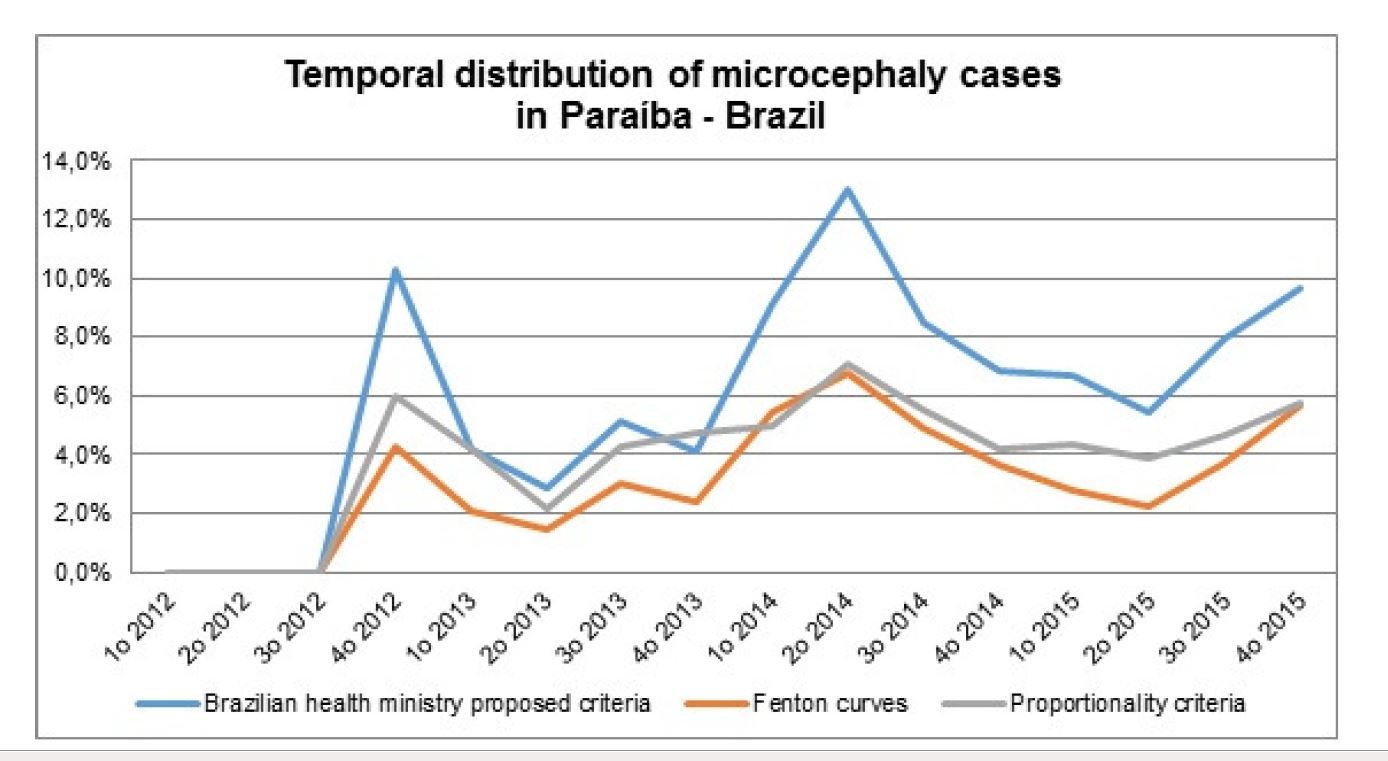
The distribution of
cases of microcephaly between 2012 and 2015 is observed in the chart. A
variation through time is observed. The numbers are greater than
expected since the end of 2012 and with its sharpest peak in mid-2014.
If the Zika virus came to Brazil in summer of 2014, then 9 months later
the cases would be elevated in 2015. But the peak you see is in early
2014.
Discussion
In 2000, Brazil
reported that the prevalence of microcephaly in Brazilian newborns was
5.5 cases/ 100,000 live births and in 2010 it was 5.7 cases / 100,000
live births. Over the last three months it went up to 99 per 100.000
live births which corresponds to a twentyfold increase. In this study,
independent of the classification criteria used, we demonstrated a much
higher incidence of microcephaly between 2012 and 2015. Projecting our
findings to the total number of live births in Paraíba area of Brazil,
in 2014 the number of neonates born with microcephaly in that year
would have been 4,652 by the Health Ministry proposed criteria, 2,442 by
the Fenton curves and 2,907 by the proportionality criteria. Neonates
classified with microcephaly by all three criteria would have been
1,105. These observations highlight the need to review the situation
carefully. Many questions need to be answered prior to concluding what
problem we are facing, how it came about and which consequences it is
likely to bring to the Brazilian population in years to come. What is
the real incidence of microcephaly in Brazil?
The numbers of very
extreme cases of microcephaly, for instance, while significantly
increasing over the last few months, are much smaller and until recently
fell within the expected ranges for the worldwide reported incidence.
Questions:
1.
Were only those extreme cases being notified?
2.
As the number of extreme cases increased over these past three or four
months, did the awareness of health professionals increase and they
started to notify milder forms which make up the majority of reported
cases?
3.
Could a 31cm head circumference in a term newborn be within normal
limits for this particular population?
4.
Could genetics or nutritional components explain these findings?
5.
Are we facing large numbers of a neurological disease or observing an
anatomic variation of normality?
Points to ponder:
1.
ZIKV has been identified in Africa over 50 years ago. Increases in
microcephaly have not been reported there or in other countries with
outbreaks of Zika.
2.
Is there another cause of the increase microcephaly such as
malnutrition, drugs, alcohol, and other viral infections? Most of the
reported cases have occurred in low-income families.
3.
Mosquito controlling strategies will help many aspects of public health
other than Zika. The scare will prevent many other diseases carried by
mosquitoes.
4.
This is a challenging health problem that limited information brings
questions to conclusions at this early stage.
There have been outbreaks of other
birth defects in the past in different countries. Anencephaly is a
condition where most of the brain is flat missing.
Estimates of the incidence of anencephaly in the United States during
this century have varied from 0.3 to 7 per 1000 births. In the United
States each year there are about 1050 infants born with anencephaly.
Overall rates are highest in the Northeast and North Central regions
and lowest in the Mountain and lower Plains states.
An anencephaly "epidemic" occured during the early 1930s in Boston and
Providence.
A mysterious cluster of anencephaly occurred
in a three-county area of rural Washington State in 2013. No cause was
found. There were nearly two dozen cases of anencephaly in three years,
a rate four times the national average. They noted that small clusters
of birth defects often turn out to be nothing more than sad coincidence.
However it can be caused by diet, drugs, alcohol, and other viral
infections that are hard to prove.
Texas has the Birth Defects Epidemiology and Surveillance Branch. BDES
was established in 1993 as the result of an unusual cluster of
anencephaly cases that occurred in Brownsville, Texas. Epidemiologic
investigations revealed a higher than expected rate of neural tube
defects among children born to Hispanic mothers living in South Texas.
In recognition that epidemiologic resources are routinely needed to
investigate birth defects clusters, the Texas State Legislature passed
the Texas Birth Defects Act in 1993, which authorized the
establishment of BDES.

So in conclusion, there are sometimes outbreaks of congenital defects of
the brain, heart or kidneys that occur. It is frequently just nature
where there is a fluctuation in the frequency of these defects. Some
are caused by factors that we cannot discover nor prove. The Zika virus
may be causing some defects or just slightly increasing the incidence or
may just be blamed for an increase that is either not real or caused by
some other factor. Time will tell. But the news loves this scare and
politicians (Obama) love to delegate 1.5 billion dollars to fix the
problem. We need a vaccine for Dengue more than we need one for Zika.
Like the boy who took the “clock” to school, wait to judge this Zika
thing until all the information is collected.
Roger Knapp MD